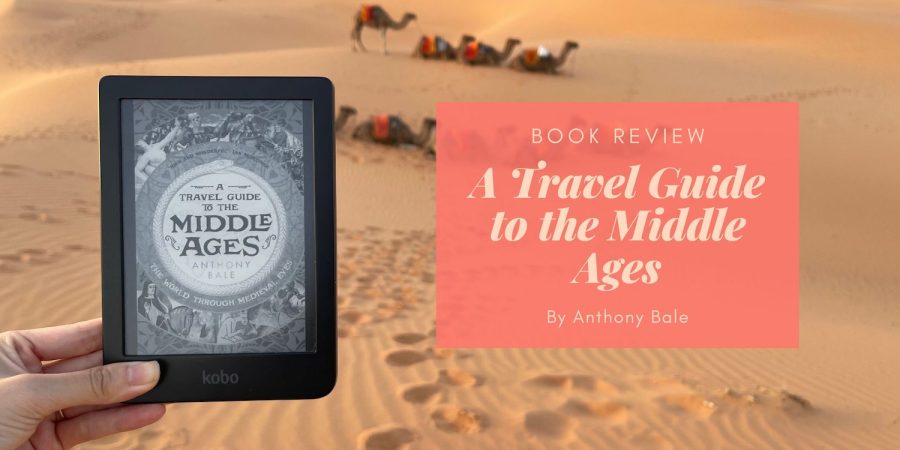I first heard about this book on the Medieval podcast (link to episode) and it sounded so interesting that I put it on the TBR list. And then when I actually went on a fairly long trip, I decided to borrow and it and I was definitely glad I did because both countries that I went to were mentioned in the book.
Following a few roads that some international travellers might have taken, Bale takes us on a trip through the world as Westerners who lived in the Middle Ages might have experienced it. We travel within Europe, learning what it takes to even go to Rome, cross the sea to Egypt and from there, head to Jerusalem. We then detour to Ethiopia, follow the Silk Road through India and eventually end up in Mongol China (and hear about the possibility of cannibals on an island called Cipangu – does the name ring any bells?). By following a few medieval travellers and looking at travel documents, Bale brings us a generalised experience of what travel in the Middle Ages would be like.
While we do learn a lot about travel in the Middle Ages, what struck me most while reading the book was how similar medieval travellers were to us. While we don’t have to get permission from our feudal lords to leave town (though I suppose applying for company leave may feel like that), we do share the same anxieties about packing, about the deja vu (and the complete opposite of a new experience) that travel sometimes bring, the misunderstandings that occur, and how our experience of a new place is guided by how we’ve been primed to think about it. One quote that made me think of how similar the travelling experience was this:
“Travel is almost always fuelled by anticipation; the beckoning of the world before us is more seductive than the clicking of the latch as we leave. The voyage promises a new self. Yet packing for the journey is disheartening. Packing reminds us of the realities of travel.”
Chapter 2: The Point of Departure
Of course, there’s much that is different in our travels now! For example, we also no longer have to pay the guard at Alexandria port 1 ducat per person while leaving and we no longer assume that it’s a good thing to be bled or to fast before a trip as a way of disciplining the body. In general, travelling is just so much easier, and likely more accessible/affordable than it was before.
Yet, we also do try to evoke a bit of the medieval when we travel. In Morocco, our night out in the desert included a camel ride there (though we slept in much more comfortable circumstances), which brought to mind the medieval travellers complaints about camels and the pains of riding! We could have just taken a 4×4 to the camp, yet there was something about the “traditional” way that clearly appeals to us. And this happens in most places – apart from the new, we also tend to seek out the old and traditional experiences in each location, and that may or may not date back to medieval times.
Because of this, I started thinking more about how each journey across the earth could also be a journey back through time, especially if we plan to learn more about the history of the places we visit. It was interesting to be reading about the Atlas mountains as we passed through it, and to think about how some towns that were deserted now were thriving in the past, and perhaps how our journey through the twisty mountain roads was the modern version of how [t]ravellers, merchants and sages lurched along on narrow tracks” (I wonder if they encountered road closures like we did!).
All in all, this was a delightful read and a very apt book to take along for a trip abroad. Apart from being educational, I found that A Travel Guide to the Middle Ages had me reflecting more broadly on the nature of travel itself and helped me to be more mindful of the whole experience. To end, here’s another quote from the book:
“In each new place he visited, in each new foreign experience, Nikitin found new versions of himself that he had not known. The foreignness of the peoples and places he encountered was transmuted into the foreignness of his own past. Travel is often longed for as an escape from the banality and laboriousness of everyday life, but Nikitin went further than this. For if we stay travelling for too long, we often feel the need to understand, even to become, the people among whom we travel.”
Chapter 11: From Persia to India

This part made me laugh: “While we don’t have to get permission from our feudal lords to leave town (though I suppose applying for company leave may feel like that)”!
I like the idea of packing reminding us of the realities of travel. I often feel like most people I know really romanticize travel and expect to find themselves on it, or something. But my mind is usually going, “Okay. Where will I eat? How will I get from A to B? What if there’s traffic? I hope they don’t ticket me.” I definitely focus more on the stressful parts!
Haha me too! When it comes to places I don’t know, I tend to be a planner (except for this trip because I was way too busy beforehand).
This sounds like a fascinating read, I adore learning about past peoples in a way that makes me think of my own life and how it compares!
This one was very interesting, I highly recommend it!